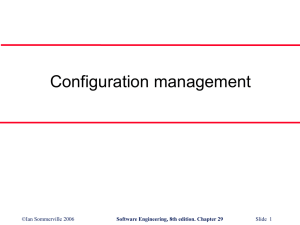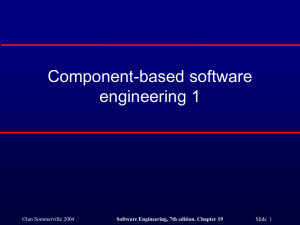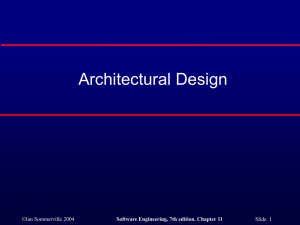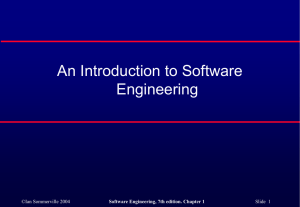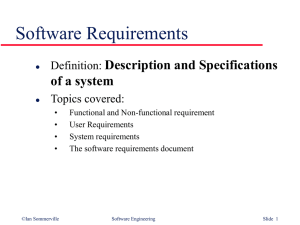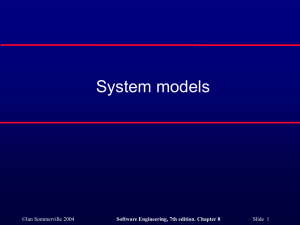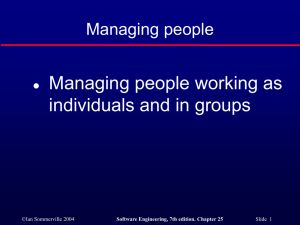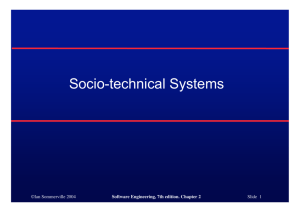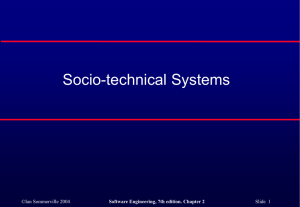Chapter 2
advertisement
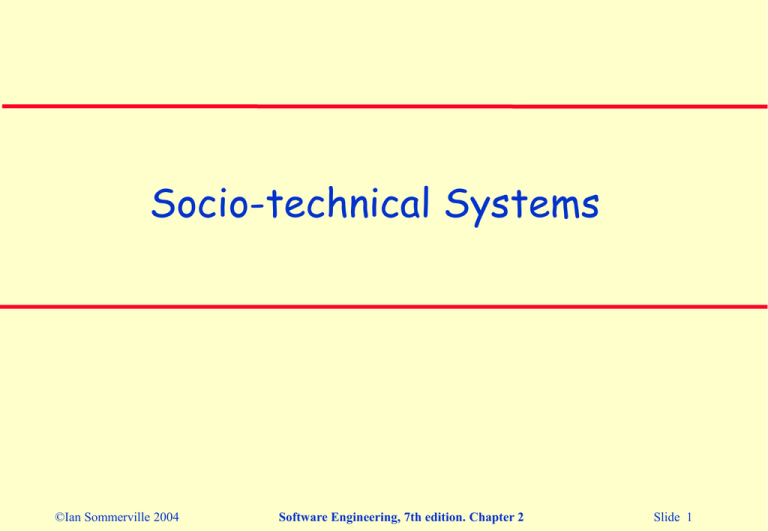
Socio-technical Systems ©Ian Sommerville 2004 Software Engineering, 7th edition. Chapter 2 Slide 1 Topics covered Emergent system properties Systems engineering Organizations, people and computer systems Legacy systems ©Ian Sommerville 2004 Software Engineering, 7th edition. Chapter 2 Slide 2 What is a system? A purposeful collection of inter-related components working together to achieve some common objective. A system may include software, mechanical, electrical and electronic hardware and be operated by people. System components are dependent on other system components The properties and behaviour of system components are inextricably inter-mingled ©Ian Sommerville 2004 Software Engineering, 7th edition. Chapter 2 Slide 3 System categories Technical computer-based systems • Systems that include hardware and software but where the operators and operational processes are not normally considered to be part of the system. The system is not self-aware. Socio-technical systems • Systems that include technical systems but also operational processes and people who use and interact with the technical system. Sociotechnical systems are governed by organisational policies and rules. ©Ian Sommerville 2004 Software Engineering, 7th edition. Chapter 2 Slide 4 Types of emergent property Functional properties • These appear when all the parts of a system work together to achieve some objective. For example, a bicycle has the functional property of being a transportation device once it has been assembled from its components. Non-functional emergent properties • Examples are reliability, performance, safety, and security. These relate to the behaviour of the system in its operational environment. They are often critical for computer-based systems as failure to achieve some minimal defined level in these properties may make the system unusable. ©Ian Sommerville 2004 Software Engineering, 7th edition. Chapter 2 Slide 5 Systems engineering Specifying, designing, implementing, validating, deploying and maintaining socio-technical systems. Concerned with the services provided by the system, constraints on its construction and operation and the ways in which it is used. ©Ian Sommerville 2004 Software Engineering, 7th edition. Chapter 2 Slide 6 The system engineering process Usually follows a ‘waterfall’ model because of the need for parallel development of different parts of the system • Little scope for iteration between phases because hardware changes are very expensive. Software may have to compensate for hardware problems. Inevitably involves engineers from different disciplines who must work together • Much scope for misunderstanding here. Different disciplines use a different vocabulary and much negotiation is required. Engineers may have personal agendas to fulfil. ©Ian Sommerville 2004 Software Engineering, 7th edition. Chapter 2 Slide 7 The systems engineering process ©Ian Sommerville 2004 Software Engineering, 7th edition. Chapter 2 Slide 8 Inter-disciplinary involvement Soft w ar e Elec tr onic Mec ha nica l engineer ing engineer ing engineer ing St ruct ur al AT C syst ems User inter f ace engineer ing engineer ing design Ci vil Elec tr ical engineer ing engineer ing ©Ian Sommerville 2004 Software Engineering, 7th edition. Chapter 2 Ar chitec tur e Slide 9 System requirements definition Three types of requirement defined at this stage • • • Abstract functional requirements. System functions are defined in an abstract way; System properties. Non-functional requirements for the system in general are defined; Undesirable characteristics. Unacceptable system behaviour is specified. Should also define overall organisational objectives for the system. ©Ian Sommerville 2004 Software Engineering, 7th edition. Chapter 2 Slide 10 System objectives Should define why a system is being procured for a particular environment. Functional objectives • To provide a fire and intruder alarm system for the building which will provide internal and external warning of fire or unauthorized intrusion. Organisational objectives • To ensure that the normal functioning of work carried out in the building is not seriously disrupted by events such as fire and unauthorized intrusion. ©Ian Sommerville 2004 Software Engineering, 7th edition. Chapter 2 Slide 11 The system design process Partition requirements • Identify sub-systems • Identify a set of sub-systems which collectively can meet the system requirements. Assign requirements to sub-systems • Organise requirements into related groups. Causes particular problems when COTS are integrated. Specify sub-system functionality. Define sub-system interfaces • Critical activity for parallel sub-system development. ©Ian Sommerville 2004 Software Engineering, 7th edition. Chapter 2 Slide 12 The system design process ©Ian Sommerville 2004 Software Engineering, 7th edition. Chapter 2 Slide 13 Spiral model of requirements/design ©Ian Sommerville 2004 Software Engineering, 7th edition. Chapter 2 Slide 14 System modelling An architectural model presents an abstract view of the sub-systems making up a system May include major information flows between sub-systems Usually presented as a block diagram May identify different types of functional component in the model ©Ian Sommerville 2004 Software Engineering, 7th edition. Chapter 2 Slide 15 Burglar alarm system ©Ian Sommerville 2004 Software Engineering, 7th edition. Chapter 2 Slide 16 Sub-system description Su b-sy stem D escr iption M o vem en t s en sors D ete c ts mo ve m en t in th e room s m on it or ed by th e sys tem D oo r se nso rs D ete c ts d oo r op en ing in th e e xter n al do ors o f the bu ildi n g A la rm co ntro ller C o ntro ls t he op eration of t he s ystem S iren E m its an a u di b le w a rn in g wh en a n intru de r is s usp ec ted V oice sy nt h esize r S yn th esiz es a v oice m essa ge g iv in g the lo ca tio n o f the s usp ec ted in tru de r Te lep h on e c a ll e r M a ke s ex ter n al ca lls t o n otify s ecu rity, th e p olice , et c . ©Ian Sommerville 2004 Software Engineering, 7th edition. Chapter 2 Slide 17 ATC system architecture ©Ian Sommerville 2004 Software Engineering, 7th edition. Chapter 2 Slide 18 Sub-system development Typically parallel projects developing the hardware, software and communications. May involve some COTS (Commercial Off-the-Shelf) systems procurement. Lack of communication across implementation teams. Bureaucratic and slow mechanism for proposing system changes means that the development schedule may be extended because of the need for rework. ©Ian Sommerville 2004 Software Engineering, 7th edition. Chapter 2 Slide 19 System integration The process of putting hardware, software and people together to make a system. Should be tackled incrementally so that subsystems are integrated one at a time. Interface problems between sub-systems are usually found at this stage. May be problems with uncoordinated deliveries of system components. ©Ian Sommerville 2004 Software Engineering, 7th edition. Chapter 2 Slide 20 System installation After completion, the system has to be installed in the customer’s environment • • • • • Environmental assumptions may be incorrect; May be human resistance to the introduction of a new system; System may have to coexist with alternative systems for some time; May be physical installation problems (e.g. cabling problems); Operator training has to be identified. ©Ian Sommerville 2004 Software Engineering, 7th edition. Chapter 2 Slide 21 System evolution Large systems have a long lifetime. They must evolve to meet changing requirements. Evolution is inherently costly • • • • Changes must be analysed from a technical and business perspective; Sub-systems interact so unanticipated problems can arise; There is rarely a rationale for original design decisions; System structure is corrupted as changes are made to it. Existing systems which must be maintained are sometimes called legacy systems. ©Ian Sommerville 2004 Software Engineering, 7th edition. Chapter 2 Slide 22 System decommissioning Taking the system out of service after its useful lifetime. May require removal of materials (e.g. dangerous chemicals) which pollute the environment • Should be planned for in the system design by encapsulation. May require data to be restructured and converted to be used in some other system. ©Ian Sommerville 2004 Software Engineering, 7th edition. Chapter 2 Slide 23 Procurement/development processes ©Ian Sommerville 2004 Software Engineering, 7th edition. Chapter 2 Slide 24 System procurement Acquiring a system for an organization to meet some need Some system specification and architectural design is usually necessary before procurement • • You need a specification to let a contract for system development The specification may allow you to buy a commercial offthe-shelf (COTS) system. Almost always cheaper than developing a system from scratch Large complex systems usually consist of a mix of off the shelf and specially designed components. The procurement processes for these different types of component are usually different. ©Ian Sommerville 2004 Software Engineering, 7th edition. Chapter 2 Slide 25 The system procurement process ©Ian Sommerville 2004 Software Engineering, 7th edition. Chapter 2 Slide 26 Contractors and sub-contractors The procurement of large hardware/software systems is usually based around some principal contractor. Sub-contracts are issued to other suppliers to supply parts of the system. Customer liases with the principal contractor and does not deal directly with subcontractors. ©Ian Sommerville 2004 Software Engineering, 7th edition. Chapter 2 Slide 27 Contractor/Sub-contractor model Syst em custom er Pr incipa l contr act or Subc ont r act or 1 ©Ian Sommerville 2004 Subc ont r act or 2 Software Engineering, 7th edition. Chapter 2 Subc ont r act or 3 Slide 28 Legacy systems Socio-technical systems that have been developed using old or obsolete technology. Crucial to the operation of a business and it is often too risky to discard these systems • • Bank customer accounting system; Aircraft maintenance system. Legacy systems constrain new business processes and consume a high proportion of company budgets. ©Ian Sommerville 2004 Software Engineering, 7th edition. Chapter 2 Slide 29 ©Ian Sommerville 2004 Software Engineering, 7th edition. Chapter 2 Slide 30 Soci o-t ec hni cal syst e m Business processes Applic ation soft war e Support soft war e Har dwar e ©Ian Sommerville 2004 Software Engineering, 7th edition. Chapter 2 Slide 31
